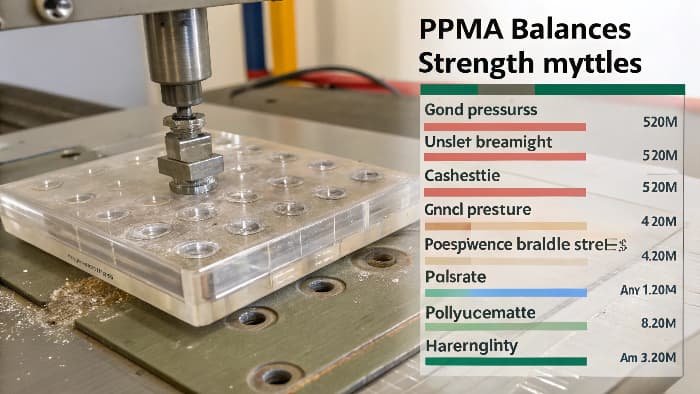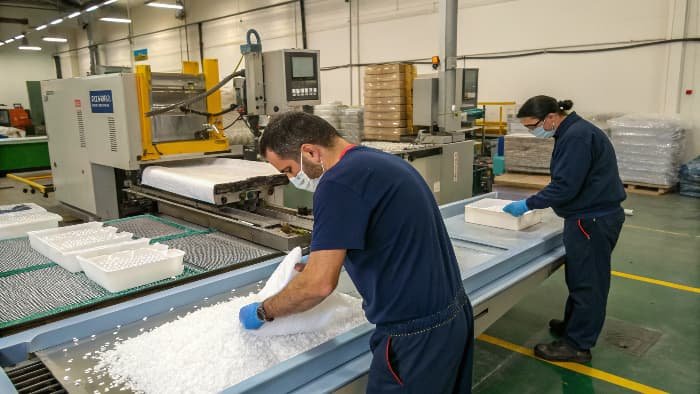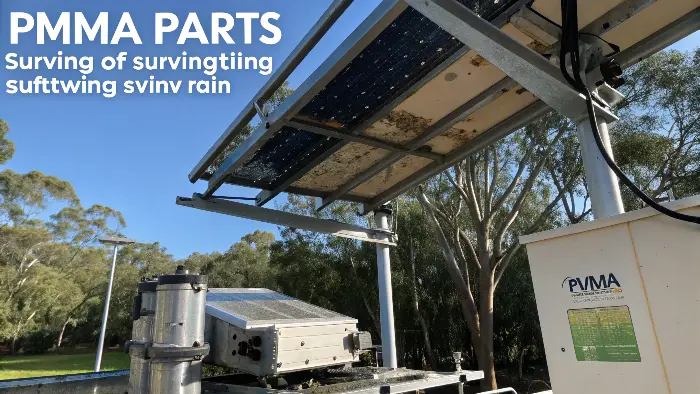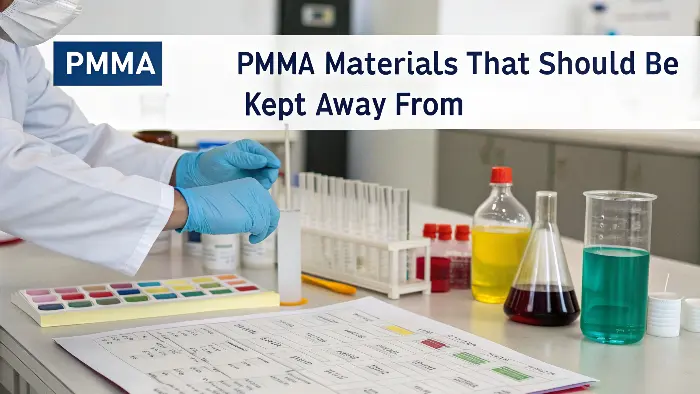Designing a part that needs to be both crystal clear and tough? PMMA, or acrylic, often comes to mind, but understanding its full profile is key to avoiding costly design errors.
PMMA (Polymethyl Methacrylate)1 is a top choice for its unmatched optical clarity2, excellent UV and weather resistance3, good surface hardness, and ease of processing, making it ideal for a wide array of transparent applications.
You know, I’ve seen PMMA used in everything from simple sight glasses to complex light guides and high-end display screens. Its versatility is a big plus. But to really leverage its strengths, you gotta understand not just what it can do, but also its limitations and how its properties interact. It’s not just about being "clear plastic"; it’s about how all its characteristics come together. At CKMOLD, we’ve learned a lot about maximizing PMMA’s potential, and I’m happy to share some of those insights.
What Gives PMMA Its Famous Crystal Clarity?
Ever looked through a piece of high-quality PMMA and felt like there was almost nothing there? That incredible transparency is why it’s so popular for optical applications, but what’s the science behind it?
PMMA’s exceptional optical clarity stems from its amorphous molecular structure, which minimizes light scattering, and its inherent ability to transmit up to 92% of visible light, combined with a low haze value and a refractive index close to glass.
I remember when we were developing a particularly sensitive optical lens for a client. The choice was between PMMA and polycarbonate. While PC is tougher, we just couldn’t beat the sheer, unadulterated clarity and light transmission of PMMA for that specific application. It was like night and day. The client was thrilled with the optical performance.
Let’s break down these optical superpowers:
1. High Light Transmittance
PMMA allows about 92% of visible light to pass through it. This is one of the highest transmission rates for any transparent plastic, even better than some types of glass! This means more light gets where it needs to go, which is crucial for things like:
- Lenses: Maximizing light capture.
- Light Guides: Efficiently channeling light from an LED source.
- Display Screens: Ensuring a bright, clear image.
2. Amorphous Structure & Low Haze
PMMA is an amorphous polymer. This means its molecular chains are arranged randomly, not in an organized, crystalline structure. Crystalline regions in plastics can scatter light, leading to haziness. Because PMMA lacks these, light passes through with minimal scattering, resulting in very low haze values and that "crystal clear" appearance. This is a big deal when you need sharp, undistorted vision through the material.
3. Refractive Index
PMMA has a refractive index of around 1.49. This is relatively close to that of crown glass (around 1.52). This similarity makes it a good candidate for many optical designs originally intended for glass, often at a lower weight and cost. It also means light bends in a predictable way, which is essential for designing effective lenses and prisms.
4. Excellent Colorability (or Lack Thereof)
In its natural state, PMMA is colorless. This is a great starting point because it means any color you see is intentionally added. For clear applications, this inherent lack of color ensures true optical neutrality. Optical Property Typical PMMA Value Significance for Design Light Transmittance ~92% (visible light) Maximum brightness, efficiency in light pipes, lenses Haze Very Low (<1-2%) Crystal clear view, minimal light diffusion Refractive Index ~1.49 Predictable light bending, suitable for lens design UV Stability Good (inherent) Resists yellowing, maintains clarity outdoors (more on this later) So, when you need something to be as clear as possible, PMMA is often the first material we think of. It’s just naturally gifted in the optics department.
How Does PMMA Balance Strength and Brittleness?
We know PMMA is clear, but how tough is it? It’s a common question, especially when parts might face some bumps or stresses. It’s strong, yes, but there’s a catch you need to be aware of.
PMMA offers good tensile strength and excellent surface hardness for a thermoplastic, making it quite durable. However, it is inherently more brittle and notch-sensitive than materials like polycarbonate, requiring careful design to avoid stress concentrations.

I recall a project for a transparent cover. The initial design had sharp internal corners. During testing, we saw cracks appearing right at those corners under minimal stress! We worked with the designer to add generous radii, and boom – problem solved. It highlighted how PMMA needs a bit of design finesse to play to its strengths.
Let’s look at the specifics:
Mechanical Strengths:
- Tensile Strength: PMMA typically has a tensile strength in the range of 60-80 MPa (megapascals). This is quite good for a clear thermoplastic and means it can withstand significant pulling forces before yielding or breaking, provided the load is applied smoothly.
- Flexural Strength: Similar to its tensile strength, PMMA shows good resistance to bending forces, often in the 90-120 MPa range.
- Surface Hardness: This is one of PMMA’s standout mechanical properties. It’s one of the hardest thermoplastics, meaning it has good scratch resistance compared to many other plastics like polycarbonate or polystyrene. This contributes to its durability in applications where surface appearance matters. Think display screens or retail fixtures.
The "Brittle" Aspect:
- Impact Strength (Notched Izod): This is where PMMA shows its more delicate side. Its notched Izod impact strength is relatively low, typically around 15-30 J/m (Joules per meter). This means if there’s a sharp notch, crack, or stress concentrator, it can fracture more easily under sudden impact compared to tougher plastics like polycarbonate (which can be 600-800 J/m or higher!).
- Notch Sensitivity: This is key. PMMA doesn’t like sharp corners or sudden changes in thickness. These areas become stress concentration points. If a crack starts, it can propagate quickly through the material.
Designing for PMMA’s Mechanical Profile:
To get the best of PMMA’s strength while mitigating its brittleness, as engineers and designers, we need to:
- Incorporate Generous Radii: Avoid sharp internal and external corners. Smooth transitions are your friend!
- Manage Stress Concentrations: Ensure even wall thicknesses and avoid features that create localized stress.
- Consider Impact Modifiers: For applications needing more toughness, impact-modified PMMA grades are available, though they might slightly compromise clarity or other properties.
-
Annealing: Sometimes, post-molding annealing can help relieve internal stresses, making the part less prone to cracking. Property Typical PMMA Range Implication for Design Tensile Strength 60-80 MPa Good load-bearing capacity under tension Flexural Strength 90-120 MPa Resists bending well Surface Hardness Rockwell M80-M100 Good scratch resistance, maintains aesthetic appeal Notched Impact Strength 15-30 J/m Can be brittle under impact, especially if notched Elongation at Break 2-10% Relatively low ductility, doesn’t stretch much before breaking So, PMMA is strong and hard, which is great for durability and appearance. But you have to treat it with respect regarding impacts and sharp features. It’s less forgiving than some other plastics, but with smart design, it performs beautifully.
Is PMMA a Dream or a Nightmare for Fabricators and Molders?
A material can have amazing properties, but if it’s a pain to make parts from, its usefulness drops. So, how does PMMA fare when it comes to turning raw pellets or sheets into finished components?
PMMA is generally considered easy to process. It can be readily thermoformed, machined, laser cut, and injection molded. However, for optimal results in injection molding, meticulous drying and precise temperature control are absolutely crucial.

I’ve seen PMMA handled in so many ways in our facility and with our partners. For sheet applications, it thermoforms like a dream – you can get really complex curves. Machining is also pretty straightforward. But when it comes to injection molding, especially for those optical-grade parts Michael often needs, it demands respect. Get the drying wrong, and you’re looking at a batch of rejects full of silver streaks. It’s not a nightmare, but it definitely requires attention to detail.
Key Processing Characteristics:
- Thermoformability: PMMA sheets soften nicely when heated (around 130-170°C or 265-340°F) and can be draped, vacuum-formed, or pressure-formed into various shapes. It holds its formed shape well upon cooling. This is great for signage, skylights, and display units.
- Machinability: PMMA can be easily sawn, drilled, routed, and polished using standard workshop tools. Sharp tools and appropriate speeds/feeds are important to prevent chipping or melting. We often machine prototypes from PMMA blocks before committing to an injection mold.
- Laser Cutting & Engraving: PMMA responds exceptionally well to laser cutting, producing a clean, flame-polished edge. It can also be engraved with fine detail.
- Joining: PMMA parts can be solvent-bonded (creating very strong, clear joints), ultrasonically welded, or mechanically fastened.
- Injection Molding: This is where things get more technical for high-quality parts:
- Drying is Critical: PMMA is hygroscopic, meaning it absorbs moisture from the air (up to ~0.3-0.4% typically). If molded wet, this moisture turns to steam, causing splay marks, silver streaks, or internal bubbles – disastrous for optical parts. It must be dried thoroughly, typically to <0.02% moisture content (e.g., 2-4 hours at 80-90°C in a desiccant dryer). I can’t stress this enough!
- Melt Temperature: Typically 200-250°C (390-480°F). Too low, and you get poor flow and surface finish; too high, and you risk degradation.
- Mold Temperature: Warm molds (60-90°C or 140-195°F) are essential for good surface replication, reduced stress, and better flow.
-
Flow Properties: PMMA is more viscous than some commodity plastics. This means runners and gates need to be adequately sized to prevent excessive shear and ensure complete filling. Processing Method PMMA’s Suitability Key Considerations Thermoforming Excellent Even heating, proper forming temperatures Machining Good to Excellent Sharp tools, appropriate speeds/feeds, cooling Laser Cutting Excellent Produces polished edge, good for intricate shapes Solvent Bonding Excellent Proper solvent choice, good surface contact Injection Molding Good (with care) Meticulous Drying, precise temp control, mold design So, overall, PMMA is quite fabricator-friendly. The main caveat is the strict drying requirement for injection molding if you want good parts. Get that right, and PMMA can be molded into beautiful, complex components.
Can PMMA Parts Really Survive the Great Outdoors?
If you’re designing something that will be exposed to sun, rain, and changing temperatures, you need a material that won’t quickly degrade. How does PMMA stack up when it comes to braving the elements?
Yes, PMMA exhibits excellent weather and UV resistance, maintaining its optical clarity and mechanical integrity over long periods of outdoor exposure. It does not yellow or become brittle as readily as many other transparent plastics.

I always point to those outdoor signs or bus stop shelters made from acrylic. Many of them have been out there for years, even decades, and they still look remarkably good. That’s a testament to PMMA’s inherent stability. We’ve supplied PMMA components for outdoor lighting fixtures and architectural glazing, and its longevity is a major selling point.
Why PMMA Excels Outdoors:
- Inherent UV Stability: The chemical structure of PMMA is inherently resistant to degradation by ultraviolet (UV) radiation from the sun. Unlike materials like unstabilized polycarbonate or polystyrene, which can yellow, haze, and become brittle relatively quickly under UV exposure, PMMA maintains its clarity and toughness for much longer. This is a huge advantage.
- Resistance to Weathering: PMMA stands up well to rain, humidity, and temperature fluctuations. It has low water absorption (after initial molding), so it doesn’t swell or lose properties significantly in damp conditions.
- Color Stability: If you’re using colored PMMA, the colors tend to remain vibrant and true, even after prolonged sun exposure, because the base polymer itself isn’t degrading and causing a color shift.
- Long-Term Performance: Many manufacturers offer PMMA grades with 10-year or even longer warranties against significant yellowing or loss of light transmission for outdoor use. This gives designers like Michael a lot of confidence.
Considerations for Outdoor Applications:
- Thermal Expansion: Like all plastics, PMMA expands and contracts with temperature changes. Designs must accommodate this movement to prevent stress buildup, especially when PMMA is framed or fastened to other materials with different expansion rates.
- Scratch Resistance: While good for a plastic, it’s not glass. In high-traffic outdoor areas prone to abrasion, a hard coating might be considered, or the design should allow for easy replacement if scratches become an issue.
-
Impact Resistance (again): For areas prone to vandalism or very high impact (like security glazing), standard PMMA might not be sufficient. Impact-modified grades or other materials like polycarbonate would be better choices, though you might trade off some UV stability if using PC without a UV cap layer. Environmental Factor PMMA’s Performance Design Implication UV Radiation (Sun) Excellent Resistance (Inherent) Minimal yellowing, maintains clarity and strength long-term Rain / Moisture Good Resistance (Low Absorption) Dimensionally stable, properties maintained in wet conditions Temperature Cycling Good Resistance Account for thermal expansion/contraction in design Air Pollutants Generally Good Specific chemical interactions still need checking So, if your application involves being outside and looking good for a long time, PMMA is a really strong contender. Its natural ability to fend off the sun’s damaging rays is a massive plus.
What Chemicals Should I Keep Away From My PMMA Designs?
PMMA is a robust material, but it’s not invincible, especially when it comes to certain chemicals. Knowing what it can and can’t handle is crucial for part longevity and safety. So, what’s PMMA’s chemical kryptonite?
PMMA has good resistance to dilute acids, alkalis, water, and aliphatic hydrocarbons. However, it is attacked or dissolved by strong acids and alkalis, aromatic hydrocarbons (like benzene, toluene), ketones (like acetone), esters, and chlorinated solvents.

This is a big one for us at CKMOLD, especially during assembly or if the part is used in an environment with potential chemical exposure. I remember a client had PMMA housings that started crazing (developing fine surface cracks). It turned out the cleaning agent they were using on an adjacent metal part contained a ketone that was splashing onto the PMMA. A simple change in cleaning procedure saved the day, but it highlights the importance of chemical compatibility.
General Chemical Resistance Profile:
- Good Resistance To:
- Water (fresh and salt)
- Dilute acids (e.g., vinegar, some fruit juices)
- Dilute alkalis (e.g., some soap solutions)
- Aliphatic hydrocarbons (e.g., hexane, mineral oil, gasoline – though prolonged immersion might cause swelling)
- Oils and greases (many types)
- Poor Resistance To (Attacked, Swells, or Dissolves):
- Ketones: Acetone, MEK (Methyl Ethyl Ketone) – these are often used as solvents for PMMA, so they will readily attack it.
- Esters: Ethyl acetate, butyl acetate (common in paint thinners, nail polish remover).
- Aromatic Hydrocarbons: Benzene, toluene, xylene (found in some strong solvents and fuels).
- Chlorinated Solvents: Methylene chloride, chloroform, carbon tetrachloride (strong paint strippers, degreasers).
- Strong Acids: Concentrated sulfuric acid, nitric acid.
- Strong Alkalis: Concentrated sodium hydroxide.
- Alcohols: While it can handle some short-term exposure to lower alcohols like ethanol or isopropanol, prolonged contact, especially under stress, can cause issues like crazing. Methanol is generally more aggressive.
Stress Crazing – A Critical Concern:
PMMA is susceptible to environmental stress crazing (ESC). This means that even if a chemical doesn’t outright dissolve PMMA, exposure to it while the part is under mechanical stress (either molded-in stress or applied stress) can lead to the formation of fine surface cracks (crazes). These crazes can eventually grow into larger cracks and cause part failure.
- Molded-in Stress: This is why proper molding practices (correct temperatures, pressures, cooling) are vital to minimize internal stresses in PMMA parts. Annealing can also help.
- Applied Stress: Bending, torquing, or even tight-fitting fasteners can create stress.
Always Test!
Chemical resistance charts provide good general guidance, but for critical applications, it’s always best to test PMMA with the specific chemicals and conditions it will encounter. Factors like concentration, temperature, exposure time, and stress levels all play a role. Chemical Category PMMA Compatibility Examples Water, Dilute Aqueous Solns Good Tap water, mild soap solutions Aliphatic Hydrocarbons Fair to Good Hexane, mineral oil, gasoline (short exposure) Alcohols Limited (can cause crazing) Ethanol, Isopropanol (Methanol is worse) Ketones, Esters Poor (Attacks/Dissolves) Acetone, MEK, ethyl acetate Aromatic Hydrocarbons Poor (Attacks/Dissolves) Benzene, toluene, xylene Chlorinated Solvents Poor (Attacks/Dissolves) Methylene chloride, chloroform Strong Acids / Alkalis Poor (Attacks) Concentrated H₂SO₄, NaOH Understanding PMMA’s chemical compatibility is absolutely key to designing durable parts. If there’s any doubt, ask your material supplier or, better yet, test it yourself under real-world conditions.
Conclusion
PMMA is a star performer for optical clarity, weather resistance, and processability. Understanding its balance of strength, brittleness, and chemical sensitivities allows engineers and designers to harness its full potential effectively. It’s a CKMOLD favorite for good reason!
-
Explore this link to gain a deeper understanding of PMMA’s properties and its diverse applications, which can help in your design decisions. ↩
-
Understanding the significance of optical clarity can enhance your design choices, ensuring functionality and aesthetics in your projects. ↩
-
Learn about the impact of UV and weather resistance on material longevity, crucial for outdoor applications and sustainability. ↩
